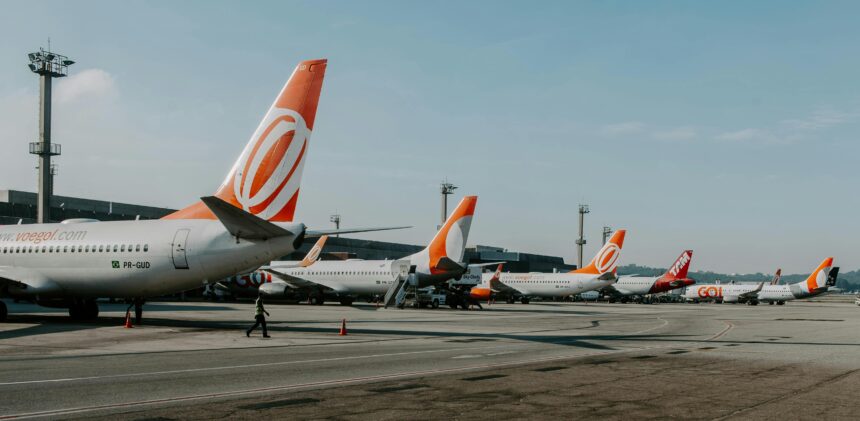A Mid-Air Crisis Unfolds
In an unprecedented turn of events, two Delta Spirit planes collide mid-air, leaving aviation experts and the general public in utter disbelief. This catastrophic incident has raised numerous questions about air safety, protocol adherence, and technological reliability. The purpose of this blog post is to provide a detailed account of the incident, explore its implications, and discuss measures for preventing such occurrences in the future.
Understanding the Delta Spirit Incident
What Happened?
On [specific date], two planes operated by Delta Spirit Airlines were involved in a mid-air collision. While the initial reports were fragmented, subsequent investigations have provided a clearer picture of the events leading up to the collision.
Immediate Consequences
The collision resulted in significant damage to both aircraft, necessitating emergency landings. Thankfully, due to quick thinking by the pilots and crew, all passengers survived, albeit with some injuries. This incident underscores the critical importance of emergency preparedness and the skill of aviation professionals.
How Rare Are Mid-Air Collisions?
Mid-air collisions are exceedingly rare, thanks to stringent regulations and advanced technology designed to prevent such incidents. When they do occur, they often result from a combination of human error and technical malfunction.
The Role of Air Traffic Control
Monitoring and Communication
Air Traffic Control (ATC) plays a pivotal role in ensuring the safe passage of aircraft. Controllers are responsible for monitoring flight paths and communicating with pilots to prevent potential collisions. In the case of the delta spirit planes collide, a breakdown in this communication chain was a contributing factor.
Rules and Regulations
Various regulations govern air traffic control procedures to maintain sky safety. These rules are designed to create buffer zones around aircraft, ensuring they maintain a safe distance from one another. The Delta Spirit incident has prompted a reevaluation of these regulations and their implementation.
Human Element
Despite advancements in automation, human controllers remain essential. Their ability to make quick, informed decisions can be the difference between a routine flight and a disaster. This incident highlights the need for ongoing training and support for ATC personnel.
Technological Safeguards
Traffic Collision Avoidance System (TCAS)
One of the most critical technologies in preventing mid-air collisions is the Traffic Collision Avoidance System (TCAS). This system alerts pilots to potential conflicts and provides guidance to avoid them. However, it is not foolproof and can be subject to limitations.
Automation in Aviation
The aviation industry has increasingly turned to automation to enhance safety. Automated systems can monitor multiple variables simultaneously, providing a level of oversight that human controllers alone cannot achieve. However, the Delta Spirit collision demonstrates that these systems are not infallible.
Future Innovations
Research and development in aviation technology continue to push boundaries. Innovations such as AI-driven air traffic management promise to enhance safety further. The lessons learned from the Delta Spirit collision will undoubtedly inform these advancements.
Investigative Procedures
Initial Response
The immediate response to the collision involved securing the safety of passengers and crew, followed by an initial assessment of the damage. Emergency teams worked swiftly to manage the situation and prevent further complications.
Formal Investigation
A formal investigation was launched to determine the cause of the collision involving the delta spirit planes collide. This process involved multiple stakeholders, including aviation authorities, airline representatives, and independent experts. The goal was to identify the root causes and recommend measures to prevent recurrence.
Findings and Recommendations
The investigation uncovered multiple factors contributing to the collision, including communication breakdowns and potential technical malfunctions. Recommendations included enhancing training for ATC personnel, upgrading technological systems, and revisiting safety protocols.
Impact on Delta Spirit Airlines
Operational Disruptions
The collision had immediate operational impacts on Delta Spirit Airlines. Flight schedules were disrupted, and resources were diverted to manage the aftermath. The airline also faced scrutiny from regulatory bodies and the public.
Financial Repercussions
The financial implications of the incident were significant. Costs associated with emergency response, repairs, and legal liabilities added up quickly. Additionally, the airline faced potential loss of customer trust, impacting future bookings.
Reputation Management
Managing the fallout from such an incident is crucial for any airline. Delta Spirit implemented a comprehensive crisis management strategy, including transparent communication with stakeholders and measures to reassure passengers about future safety.
Broader Industry Implications
Regulatory Changes
The Delta Spirit collision has prompted a reevaluation of existing regulations governing air traffic control and aviation safety. Regulatory bodies are considering new measures to enhance oversight and mitigate the risk of similar incidents.
Technological Upgrades
The incident has accelerated the push for technological advancements in aviation safety. Airlines and manufacturers are exploring new technologies to improve real-time monitoring and collision avoidance.
Industry Best Practices
The lessons learned from the Delta Spirit collision are being integrated into industry best practices. These include enhanced training for aviation professionals, improved communication protocols, and the adoption of new safety technologies.
Passenger Safety and Experience
Emergency Protocols
The incident highlighted the importance of emergency protocols in aviation. Passengers and crew received training on how to respond in such situations, which proved invaluable in ensuring their safety during the collision.
Enhancing In-Flight Safety
Airlines are continually working to enhance in-flight safety measures. This includes regular maintenance of aircraft, ongoing training for crew members, and the use of advanced safety technologies.
Building Passenger Trust
Rebuilding passenger trust after such an incident is crucial. Airlines must demonstrate their commitment to safety through transparent communication, prompt action on recommendations, and visible improvements in safety measures.
The Psychological Impact on Passengers and Crew
Immediate Reactions
The immediate aftermath of the collision was marked by shock and fear among passengers and crew. The suddenness of the event and the potential for disaster had a profound effect on all involved.
Long-Term Effects
The psychological impact of such an incident can be long-lasting. Passengers and crew may experience anxiety, fear of flying, and other stress-related symptoms. Airlines often provide counseling and support services to help them cope.
Building Resilience
Building resilience among passengers and crew involves ongoing support and fostering a culture of safety and preparedness. Airlines must prioritize mental health and ensure that those affected receive the care they need.
Lessons Learned and Future Directions
Importance of Communication
One of the key lessons from the Delta Spirit collision is the critical importance of communication. Ensuring clear, consistent communication between pilots and air traffic control is essential for preventing such incidents.
Role of Technology
While technology plays a vital role in aviation safety, it is not a substitute for human oversight. Ensuring that technological systems are reliable, up-to-date, and effectively integrated with human operations is crucial.
Continuous Improvement
The aviation industry must adopt a mindset of continuous improvement. Learning from incidents like the Delta Spirit collision and implementing changes based on those lessons is essential for enhancing safety and preventing future occurrences.
Frequently Asked Questions
What exactly caused the Delta Spirit planes to collide?
The collision resulted from a combination of factors, including communication breakdowns between pilots and air traffic control, potential technical malfunctions, and unexpected changes in flight paths. The formal investigation provided a detailed account of these contributing elements.
How can air traffic control prevent future collisions?
Air traffic control can prevent future collisions by enhancing communication protocols, providing ongoing training for controllers, and integrating advanced technologies like AI-driven traffic management systems. Regular audits and updates to procedures also play a crucial role.
Are mid-air collisions common in aviation?
Mid-air collisions are extremely rare in modern aviation due to stringent regulations, advanced technology, and rigorous training for pilots and air traffic controllers. When they do occur, they usually result from a combination of human error and technical issues.
What steps is Delta Spirit taking to improve safety after the collision?
Delta Spirit is implementing several measures to improve safety, including enhancing pilot and controller training, upgrading technological systems, and revisiting safety protocols. The airline is also working closely with regulatory bodies to ensure compliance with new guidelines.
How did passengers and crew react during the incident?
Passengers and crew experienced shock and fear during the incident. However, due to their training and quick thinking, they managed to respond effectively, ensuring their safety until emergency services arrived.
What are the financial implications for Delta Spirit Airlines?
The financial implications for Delta Spirit include costs associated with emergency response, repairs, legal liabilities, and potential loss of customer trust. The airline is also investing in safety improvements to prevent future incidents.
How can passengers ensure their safety during a flight?
Passengers can enhance their safety during a flight by paying attention to safety briefings, following crew instructions, and familiarizing themselves with emergency procedures. Staying calm and alert during an emergency is also crucial.
What are the broader industry implications of the Delta Spirit collision?
The collision has prompted a reevaluation of regulations, accelerated technological advancements, and influenced industry best practices. The lessons learned are being integrated into training programs, safety protocols, and technological developments across the aviation sector.
How can the aviation industry support the mental health of passengers and crew after such incidents?
The aviation industry can support mental health by providing access to counseling and support services, fostering a culture of safety and preparedness, and ensuring ongoing communication with those affected. Building resilience involves addressing both immediate and long-term psychological impacts.
Conclusion
The Delta Spirit collision serves as a stark reminder of the complexities and risks inherent in aviation, particularly as the delta spirit planes collide highlights the potential dangers. It underscores the critical importance of communication, technological reliability, and continuous improvement in ensuring the safety of passengers and crew. By learning from this incident and implementing recommended measures, the aviation industry can enhance safety and prevent future occurrences.
For further insights into aviation safety and the latest developments in the industry, stay tuned to our blog. Together, we can build a safer and more reliable future for air travel.
Also Read: Meet the Press S76E46: Revealing Insights and Impact.




